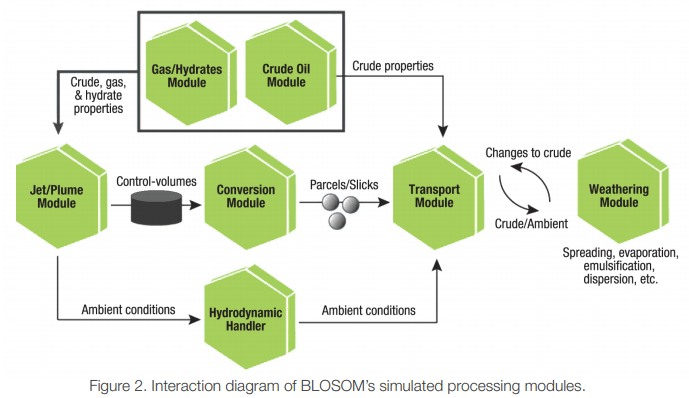My initial work for the U.S. Department of Energy, National Energy Technology Laboratory back in 2014, was as the oceanographer and mathematician in a team developing the first open-source blowout and oil-spill model, BLOSOM (BLOwout and Spill Occurrence Model). The Deepwater Horizon accident revealed the need for an open-source model that would simulate the fate of oil during a blowout, including transport and weathering, while allowing researchers to look under the hood rather than using a black box. Open source also means it is available to anyone interested without costs.
BLOSOM is composed of several modules:

Credit: https://netl.doe.gov/sites/default/files/rdfactsheet/R-D193_2.pdf
As an oceanographer, I lead development of the transport module which deals with advection and diffusion of oil in the ocean. I also assisted with the jet/plume module which simulates the blowout as a buoyant jet, the conversion module which converts a jet into oil droplets of certain sizes, and the hydrodynamic handler, which reads and prepares oceanographic data from models or observations.
As a mathematician, I was involved in general with efficient algorithms and with numerics. Solving stochastic differential equations numerically for a random flight diffusion parameterization was a fun part of the work I did at the intersection of math and ocean physics (even if at the end I decided we would stick to a random walk).
In later years I helped develop and implement a dispersant module, with which one could simulate the application of dispersants at the sea surface, or at depth. This now allows researchers to assess the effects dispersants before adding them—a possibility that was not available when the decision was made to add dispersants at depth during the Deepwater Horizon accident.
The following schematic shows scenarios where BLOSOM may be used: Credit: https://netl.doe.gov/sites/default/files/rdfactsheet/R-D193_2.pdf
Credit: https://netl.doe.gov/sites/default/files/rdfactsheet/R-D193_2.pdf
References
- Sim, L., J. Graham, K. Rose, R. Duran, J. Nelson, J. Umhoefer and J. Vielma (2015). Developing a Comprehensive Deepwater Blowout and Spill Model. NETL-TRS-9-2015; EPAct Technical Report Series. U.S. Department of Energy, National Energy Technology Laboratory: Albany, OR, 2015; p 44.
https://edx.netl.doe.gov/dataset/developing-a-comprehensive-deepwater-blowout-and-spill-model - Duran, R. (2016). Sub-Grid Parameterizations for Oceanic Oil-Spill Simulations. NETL-TRS-9-2016; EPAct Technical Report Series. U.S. Department of Energy, National Energy Technology Laboratory: Albany, OR; p 36.
https://edx.netl.doe.gov/dataset/sub-grid-parameterizations-for-oceanic-oil-spill-simulations - G.T. Bonheyo, K. Rose, A. Bunn, A. Avila, T. Bays, V. Cullinan, R. Duran, R. Jeters, L-J. Kuo, J. Park, J. Vielma, E. Winder, P. Wingo (2017). Analysis Of How Environmental Conditions Affect Dispersant Performance During Deep Ocean Application. PNNL-26935. Bureau of Safety and Environmental Enforcement, Washington, DC. p 173.
https://www.bsee.gov/research-record/osrr-1066-analysis-how-environmental-conditions-affect-dispersant-performance-during